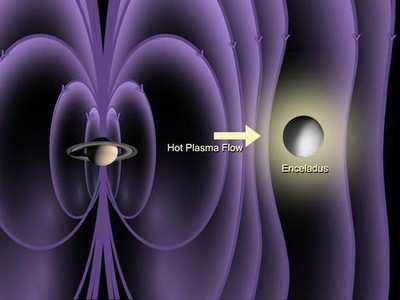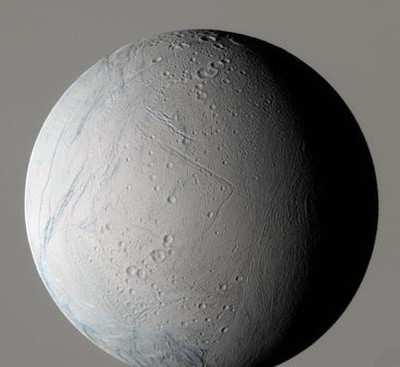The Latest Find: Enceladus
The Cassini spacecraft's two close flybys of Saturn’s icy
moon Enceladus have revealed that the moon has a significant
atmosphere. Scientists, using Cassini's magnetometer
instrument for their studies, say the source may be volcanism,
geysers, or gases escaping from the surface or the interior.
When Cassini had its first encounter with Enceladus on Feb. 17
at an altitude of 1,167 kilometers (725 miles), the magnetometer
instrument saw a striking signature in the magnetic field. On March
9, Cassini approached to within 500 kilometers (310 miles) of
Enceladus’ surface and obtained additional evidence.

The observations showed a bending of the magnetic field, with
the magnetospheric plasma being slowed and deflected by the moon.
In addition, magnetic field oscillations were observed. These
are caused when electrically charged (or ionized) molecules
interact with the magnetic field by spiraling around the field
line. This interaction creates characteristic oscillations in the
magnetic field at frequencies that can be used to identify the
molecule. The observations from the Enceladus flybys are
believed to be due to ionized water vapor.
"These new results from Cassini may be the first evidence of
gases originating either from the surface or possibly from the
interior of Enceladus," said Dr. Michele Dougherty, principal
investigator for the Cassini magnetometer and professor at Imperial
College in London. In 1981, NASA's Voyager spacecraft
flew by Enceladus at a distance of 90,000 kilometers (56,000 miles)
without detecting an atmosphere. It's possible detection was
beyond Voyager’s capabilities, or something may have changed
since that flyby.
This is the first time since Cassini arrived in orbit around
Saturn last summer that an atmosphere has been detected around a
moon of Saturn, other than its largest moon, Titan. Enceladus is a
relatively small moon. The amount of gravity it exerts is not
enough to hold an atmosphere very long. Therefore, at
Enceladus, a strong continuous source is required to maintain the
atmosphere.
The need for such a strong source leads scientists to consider
eruptions, such as volcanoes and geysers. If such eruptions are
present, Enceladus would join two other such active moons, Io at
Jupiter and Triton at Neptune. "Enceladus could be Saturn’s
more benign counterpart to Jupiter’s dramatic Io," said Dr.
Fritz Neubauer, co-investigator for the Cassini magnetometer, and a
professor at the University of Cologne in Germany.

Since the Voyager flyby, scientists have suspected that this
moon is geologically active and is the source of Saturn's icy E
ring. Enceladus is the most reflective object in the solar system,
reflecting about 90 percent of the sunlight that hits it. If
Enceladus does have ice volcanoes, the high reflectivity of the
moon's surface might result from continuous deposition of icy
particles originating from the volcanoes.
Enceladus' diameter is about 500 kilometers (310 miles), which
would fit in the state of Arizona. Yet despite its small
size, Enceladus exhibits one of the most interesting surfaces of
all the icy satellites.
 NTSB Final Report: Rutan Long-EZ
NTSB Final Report: Rutan Long-EZ ANN FAQ: Turn On Post Notifications
ANN FAQ: Turn On Post Notifications Classic Aero-TV: ICAS Perspectives - Advice for New Air Show Performers
Classic Aero-TV: ICAS Perspectives - Advice for New Air Show Performers ANN's Daily Aero-Linx (06.28.25)
ANN's Daily Aero-Linx (06.28.25) Aero-News: Quote of the Day (06.28.25)
Aero-News: Quote of the Day (06.28.25)




